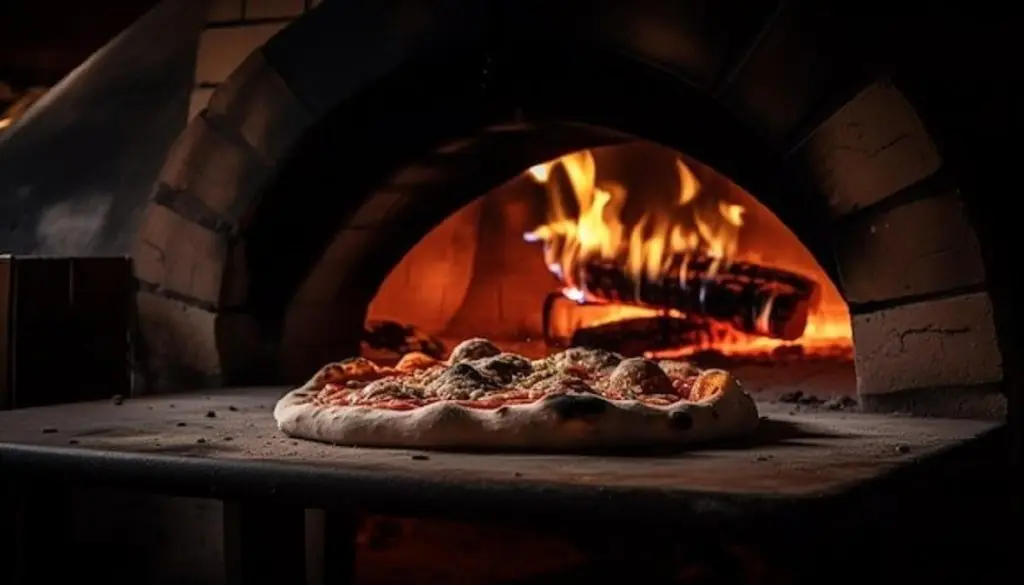I guess you are ready to take your grilling game to the next level and have been thinking of adding a pizza oven to your cooking arsenal. But are not sure whether to pick a gas or a wood-fired pizza oven. Well, you are not alone, the “gas vs wood pizza oven” debate has been simmering for decades, drawing in professional pizzaiolos and home chefs alike.
If you are wondering whether to choose a gas or wood pizza oven, continue reading. In this article, we are going to list the benefits of both gas and wood-burning pizza ovens, discuss the differences between the two, and share some insightful tips to help you choose between pizza oven wood vs. gas. In the end, we will also be answering some FAQs about the gas vs wood pizza oven debate.
So, let’s get started!
Table of contents
Benefits of Wood Pizza Ovens
Wood-fired pizza ovens, the epitome of traditional pizza-making, have captivated culinary enthusiasts for centuries. Their allure extends far beyond their rustic charm, as they impart a unique flavor profile and an unparalleled pizza-making experience.
Tantalizing Smoky Flavor and Perfect Crust
Fueled by burning wood, wood-fired ovens impart the signature smoky flavor and crispy crust that is unmatched by other cooking methods. The intense heat generated by the burning wood creates a rapid cooking process, caramelizing toppings and charring the crust to perfection. The result is an explosion of flavors that tantalize the taste buds, leaving an indelible mark on every bite.
Neapolitan Pizza Experience
Wood-fired ovens embody the authentic Neapolitan pizza experience, adhering to the strict guidelines of the Associazione Verace Pizza Napoletana (AVPN). These ovens reach temperatures of over 900°F, emulating the traditional cooking conditions that originated in Naples, Italy. The blistering heat sears the crust in mere seconds, creating a light, airy interior and a distinctively charred exterior—characteristic of Neapolitan-style pizza. VEVOR 46” Wood-Fired Artisan Pizza Oven can reach a max temperature of 1000°F.

Maillard reaction
Scientifically, wood-fired ovens offer a unique advantage due to the Maillard reaction. This chemical reaction between amino acids and sugars, accelerated by the high heat, produces complex flavor compounds that contribute to the distinctive taste of wood-fired pizzas. Additionally, the rapid cooking process preserves the nutrients and vitamins in the toppings, enhancing the overall nutritional value of the pizza.
Heat Retention
The dense materials used in wood ovens, such as brick or stone, excel in retaining heat. This allows for consistently high cooking temperatures, which is key to baking perfect pizzas in succession without sacrificing quality.
Rustic Charm and Inviting Ambiance
Wood-fired ovens exude an irresistible rustic charm that transcends culinary appeal. Their presence transforms any backyard or patio into an outdoor culinary haven, fostering a sense of community and shared experiences. The flickering flames and enticing aroma of burning wood create an ambiance that is both captivating and inviting.
Symbol of Culinary Excellence
Culturally, wood-fired ovens have long held a special place in many societies. In Italy, they are considered a symbol of culinary excellence. Many professional pizzaiolos only cook with wood-fired pizza ovens because it is the only way to make authentic pizza.
Wood-fired pizza ovens stand as a testament to culinary heritage, offering a unique combination of flavor, authenticity, and traditional appeal.
Benefits of Gas Pizza Ovens
While wood-fired ovens captivate pizza enthusiasts with their traditional allure and smoky flavor, gas pizza ovens offer a versatile and convenient alternative. Let’s explore the distinct benefits of gas pizza ovens that make them popular among pizza enthusiasts.
Convenience
Gas pizza ovens eliminate the need for sourcing and managing firewood, offering a hassle-free approach to pizza-making. With a simple turn of a knob, gas ovens ignite instantly, reaching searing temperatures in a matter of minutes. This convenience is particularly appealing to those who lead busy lifestyles or seek a spontaneous pizza-making experience.
Precision Cooking
Gas pizza ovens provide unparalleled temperature control, always ensuring consistent cooking and perfectly baked pizzas. Unlike wood-fired ovens, which require constant monitoring and adjustment, gas ovens maintain a steady heat, preventing hot spots or uneven cooking. This precision is particularly beneficial for those who are new to pizza-making and want to achieve consistent results.
Faster Cooking
Gas pizza ovens heat up quickly, reaching temperatures of over 600°F in a matter of minutes. This rapid heating capability significantly reduces cooking time, allowing you to prepare delicious pizzas in a fraction of the time compared to traditional wood-fired pizza ovens. This efficiency makes gas ovens ideal for impromptu gatherings or last-minute pizza cravings.
Generally, gas pizza ovens are not able to match the high-temperature ranges of wood-fired pizza ovens. But advanced gas pizza ovens such as this VEVOR 16-inch Gas Fired Pizza Maker can easily reach the maximum temperature of 1000℉, making a convenient alternative to wood ovens.

Environmental Considerations and Cost-Savings
Gas pizza ovens offer environmental benefits over wood-fired ovens. Gas is a cleaner-burning fuel, emitting fewer pollutants and reducing the environmental impact of pizza-making. Gas ovens can be more cost-effective to operate over time, as gas is generally less expensive than wood.
Striking a harmonious balance between convenience, precision, and efficiency, gas pizza ovens make an ideal choice for busy individuals, families, and pizza enthusiasts who are not looking for smoky flavor.
Gas vs Wood Fired Oven: What’s the Difference?
The gas vs wood pizza oven debate is as passionate as it is nuanced. Each approach boasts distinct advantages that cater to different preferences and cooking styles. Let’s uncover the key differences that set them apart.
Temperature Control
Gas pizza ovens offer precise temperature regulation, allowing you to adjust the heat with ease by adjusting the knob. This precision ensures consistent cooking and prevents hot spots or uneven baking.
In contrast, wood-fired ovens require constant monitoring and adjustment, leading to inconsistent results, especially for those new to pizza making.
Cooking Time
Gas ovens heat up rapidly, reaching temperatures of over 600°F in a matter of minutes. This rapid heating capability translates to faster cooking times, with pizzas typically ready in a couple of minutes.
On the other hand, Wood-fired ovens require a longer preheating time, often taking up to 45 minutes or even an hour to reach optimal temperatures. However, once preheated, wood-fired ovens cook pizzas incredibly quickly, with cooking times typically between 60-90 seconds.
Flavor Profile
The flavor profile of pizzas is perhaps the most hotly contested aspect of the gas vs wood pizza oven debate. Wood-fired ovens impart a distinct smoky, earthy flavor to pizzas, resulting from the combustion of wood, which is a hallmark of the traditional Neapolitan-style pizza.
Though gas pizza ovens cannot impart the same smoky character, they can produce delicious pizzas with a slightly crispier crust.
Impact of Fuel Choice on Crust Texture
The fuel choice also significantly impacts the texture of the pizza crust. While gas ovens produce a slightly crispier crust due to the consistent heat distribution, wood-fired ovens tend to produce a slightly softer, more airy crust due to the rapid cooking process and the smoky environment.
Overall Performance
Gas ovens provide convenience, precision, and consistent results, making them ideal for busy individuals and those new to pizza making and seeking consistent results.
On the other hand, Wood-fired ovens cater to those who appreciate the traditional allure, the unique smoky flavor profile, and the rustic appearance of burning wood. They demand more attention and expertise but reward the pizzaiolo with an authentic Neapolitan pizza experience.
How to Know Which One is Best for You, Gas or Wood Pizza Oven?
When deciding between a gas and wood pizza oven, take into account factors such as your unique pizza-making style, cooking needs, budget, and skill level. Evaluate the benefits of both gas and wood pizza ovens and consider their distinguishing features.
If you are unable to decide and would like to get the best of both worlds, you may want to get yourself a multi-fuel pizza oven, which will burn both gas and wood.

Best VEVOR Pizza Oven for Making Awesome Pies at Home
Whether you are looking for a gas or wood pizza oven or a multi-fuel pizza oven that will burn on both gas and wood, VEVOR has got you covered. We offer a wide collection of pizza ovens to cater to diverse cooking styles and needs. All of our pizza ovens, regardless of the type, are manufactured with high-quality stainless steel, promising durability and longevity. While generally, gas pizza ovens are not able to reach temperatures as high as wood ovens, our 16” Gas Fired Pizza Maker can easily reach a max temperature of 1000℉.

FAQs about Gas vs Wood Pizza Oven
Q: Can gas and wood be used simultaneously in the pizza oven?
Yes, some multi-fuel pizza ovens allow you to burn both gas and wood simultaneously. Before you burn wood and gas simultaneously in your pizza oven, look for the manufacturer’s instructions, as the two fuels require different combustion environments and cannot effectively coexist within the same chamber unless they are specially designed for simultaneous burning.
Q: Can you convert a gas pizza oven to wood?
Yes, you can convert a gas pizza oven to wood by using a conversion kit.
Q: What’s the average lifespan of a wood-fired pizza oven?
While the average lifespan of a wood pizza oven is between 10 and 20 years, it can be extended up to 25 years and even more with proper care and maintenance. Also, a lot depends on factors like materials used, usage frequency, and maintenance.
Q: Are gas pizza ovens suitable for outdoor use?
Yes, gas pizza ovens are suitable for outdoor use, provided they are designed for exterior installation. Manufactured with 430 stainless steel and cold-rolled sheet shells, the VEVOR 13-inch Outdoor Gas Pizza Oven is lightweight with folding legs, making it a perfect choice for outdoor cooking.

Conclusion
The gas vs wood pizza oven debate has captivated pizza enthusiasts worldwide, each approach offering distinct benefits, catering to different preferences and cooking styles. Gas ovens provide convenience, precision, and consistent results, making them ideal for busy individuals and those seeking a streamlined pizza-making experience. On the other hand, wood-fired ovens cater to those who appreciate tradition, authenticity, and the unique smoky flavor profile imparted by burning wood. Ultimately, the choice between a wood and gas pizza oven is personal, influenced by various factors such as cooking style, available space, and budget. Whether you choose a gas or wood pizza oven, ensure you get a quality oven from a reputed brand such as VEVOR, ensuring it continues producing delectable pizzas for many years to come.





